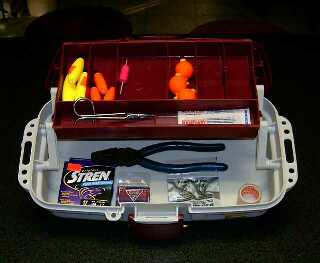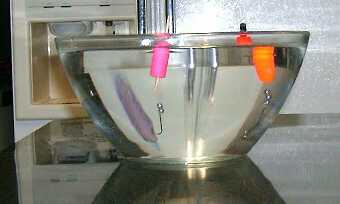Copyright 2005 by Dennis Dezendorf
Click thumbnails for full size photos
|
When a novice fisherman walks into a fishing store, there is a bewildering array of equipment, gadgets, lures, and lines that tempt us. I've been fishing all my life, but have never been able to totally disregard the colorful lures, hi-tech rods and reels, or huge tackle boxes that seem designed more to lure the fisherman than the fish. Don't let that discourage you! There are a lot of fishermen that use all that stuff and swear by it. In my favorite tackle store, the selection of plastic worms alone takes up a wall that is 20 feet long. The aisles are stocked with buzz baits, spinners, jigs, rods, vests and all manner of fishing implements. In one corner is the stuff I usually buy—hooks, sinkers and corks. I am a pole fisherman. The simplest way to get started fishing, and the way most of us started, is with a cane pole fishing for bream or perch. These little fish are everywhere, they are tasty little morsels and easily caught from the bank of a creek, lake or pond. You can fish them with a minimum of equipment. Some of this equipment will serve you well for years with nearly no maintenance. It is inexpensive and durable. If you look in the huge, multilevel boxes of tournament bass fishermen, you will find this same equipment, or more likely, if you ask they will tell you it is in their bream box. The boys that fish with monster bass boats and huge motors in tournaments worth millions of dollars per year, still keep a bream box.
That is my bream box. Looking at the picture, I see that my stringer isn't there anywhere. Before spring, I'll have to find it, or buy another. A stringer is a must-have item.
Now, lets look at how these items are used. The hook, line, sinker and cork, go on the pole. At Wal-Mart
I like the length of the fishing line to be at least as long as the pole. Some trimming is necessary during a fishing trip and having enough line on the pole is always better than not having enough. When you have rigged your pole with line, cut the line about a foot or so past the end of the butt of the pole. Selecting the correct hook is important. For bream, I like a size 6 long shank hook. When you first go to the store looking for hooks, you will be bewildered. There are literally hundreds of styles and types of hooks. Once you understand the numbering system, though, it is fairly simple to choose a hook. The smallest is size 22. They increase in size as the number decreases to number 1. Then, they continue increasing in size as a 1/0, then a 2/0, then a 3/0 all the way to size 20/0. When in doubt, go to a good tackle store and ask the counterman what size hook you need. Lets talk about corks. Some fishermen don't like corks. I find that fishing for bream is a whole lot easier when using a cork. The cork suspends the hook a pre-determined distance from the bottom and presents the bait to the fish at a given depth. The cork also lets the fisherman know when the bait is being taken. Basically, if you see the cork go under water, you know a fish is dragging it down. Lift the tip of the pole smartly with a swift, short motion to set the hook in the mouth of the fish. A cork will also tell you if your bait is presented properly, and the approximate depth of the water. If the cork isn't sitting upright in the water, then something isn't right.
Notice that the two corks are upright. The upright cork tells the fisherman that the hook is suspended off the bottom of the pond.
Fishing isn't hard. Millions of people fish each year all over the world. Spending a little time working on your gear in the winter months will guarantee that your equipment will be ready to go in the spring. I even learned something while doing the research for this article. I have to find my stringer. Fishing with a cane pole is probably the easiest, simplest, most economical way to fish. It is also one way to bring home a tasty meal. I love to bream fish. Go fishing. Good luck!
|



